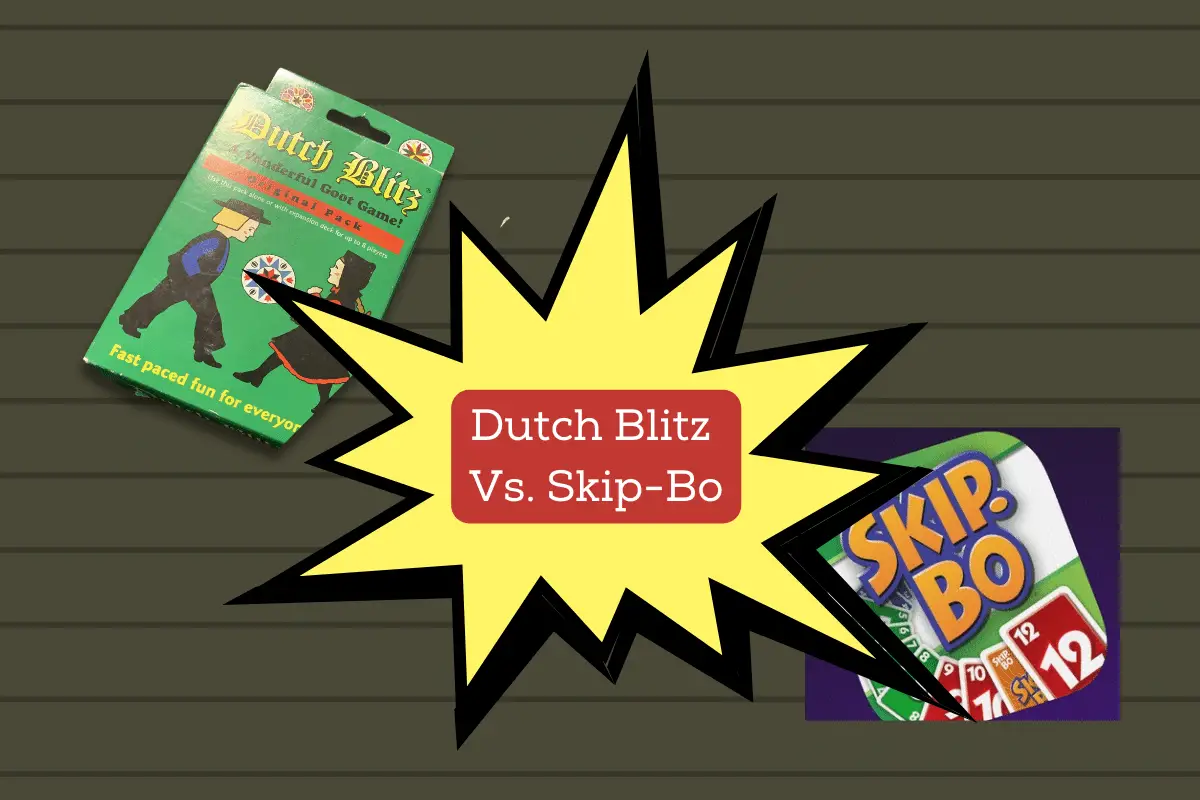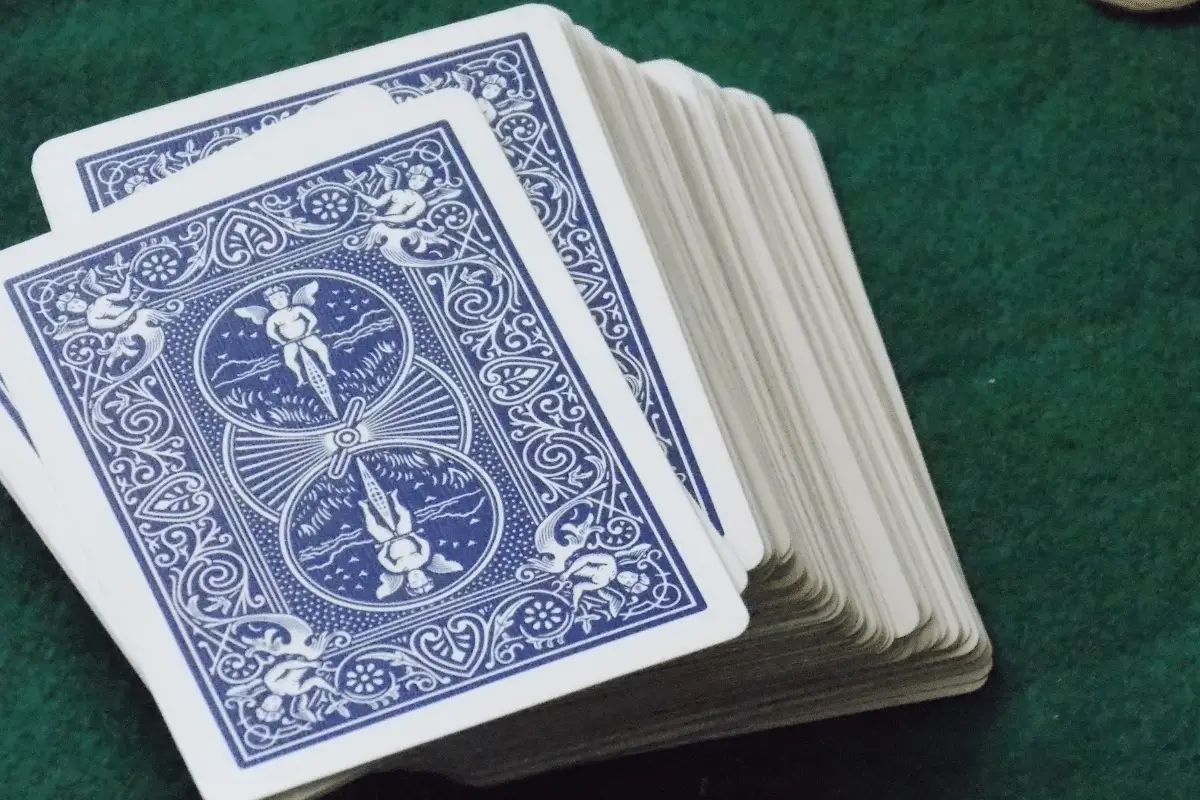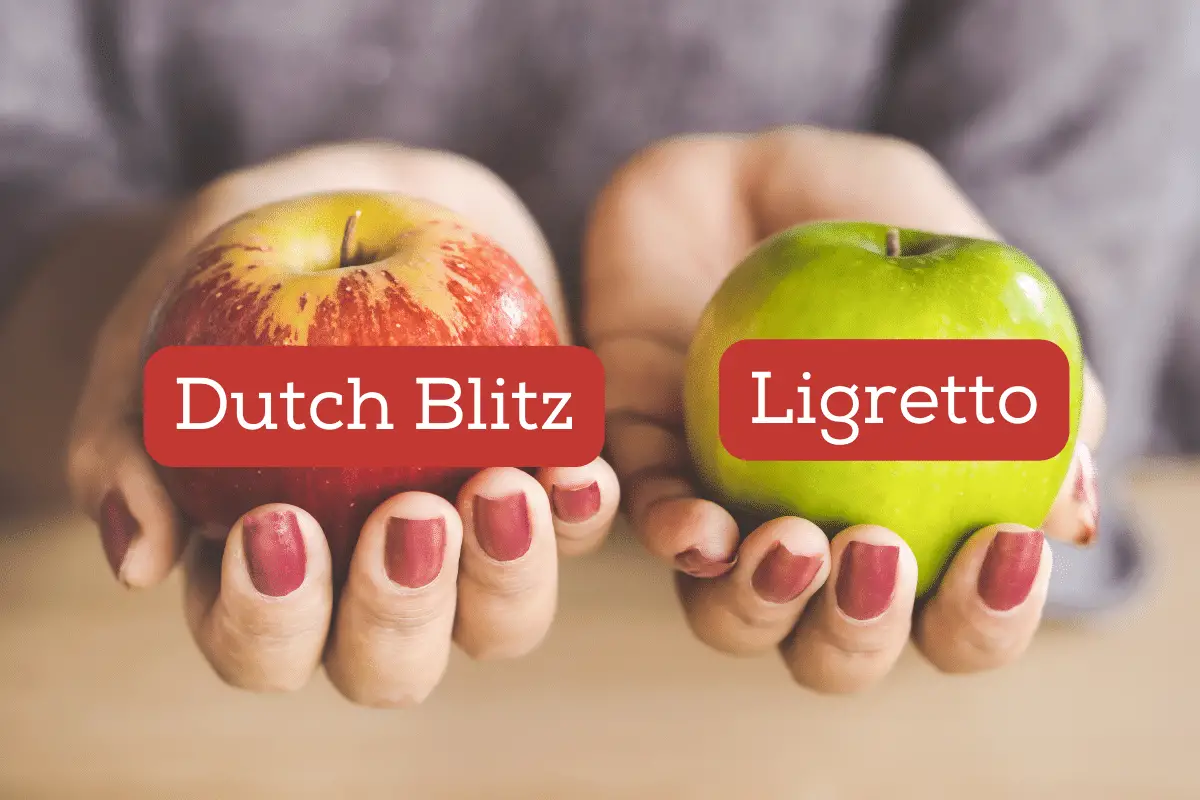When we teach new people to play Dutch Blitz, we often hear them say something like:
This reminds me of a faster version of Skip-Bo.
I hadn’t played that game in years, so I dug it out of my closet to see how similar it was.
While they have a good deal in common, they’re not exactly the same.
That’s where this Dutch Bliz vs. Skip-Bo guide comes in.
Let’s look at these two popular card games.

If you don’t know how to play Dutch Blitz, check out our complete guide for everything you need to know A to Z.
Table of Contents
Quick Reference Chart For Dutch Blitz Vs. Skip-Bo
| Element | Dutch Blitz | Skip-Bo |
|---|---|---|
| Deck Makeup | 40 cards, 4 colors, 1-10 for each person. | 144 numbered cards, 18 Skip-Bo cards, 1-12 |
| Flow of the Game | Everyone plays as fast as possible | Take turns |
| How To Win | Get to 75 points | Either be the first one out for a short game or the first one to 500 points for a long one |
| Draw Decks | You get your own; flip them over 3 at a time | Everyone plays off the same draw and picks 5 cards |
| Goal of the Hand | Empty out your Blitz Pile | Empty out your Stock Pile |
| Working Space | 3 Post Piles to help your Blitz cards out | 4 Discard Piles to work from |
| Middle Area | As many piles as possible from starting from 1-10 matching color | 4 piles starting from 1-12 colors don’t matter |
| Penalty for Not Going Out | -2 for each card not played | +5 to the one who went out for each card not played |
How Dutch Blitz And Skip-Bo Are Different
In my opinion, the games are more different than they are similar, so let’s talk about the areas where they are different here.
Makeup Of The Deck: Different
The decks are very different between the two games.
In Dutch Blitz, we have one deck per person, and each deck has its own back picture, 40 cards, and 4 different colors.
Each color has numbers from 1-10, so there are 4 sets of 1-10 in each deck.
Skip-Bo has all players working from a single deck.
There are 144 numbered cards and 18 Skip-Bo cards, or a total of 162 cards.
The numbered cards go from 1 to 12, so there are 12 sets of 12 in the whole deck.
Take Turns Vs. Everyone Play
The flow of the game is very different as well.
This makes the games feel completely different to me, as one of the critical aspects of Dutch Blitz is how everyone races to finish at the same time.
All players in Dutch Blitz go as fast they can to empty their Blitz Pile using the Post Piles and Wood Piles to help.
Skip-Bo doesn’t work the same way.
The youngest player goes first (or the person who cuts the highest card, depending on whom you ask), and then play continues in a taking-turns fashion.
Ultimate Goal For Winning
Dutch Blitz officially plays as many rounds as is needed to get to 75 points.
They have a Blitz Pile where if you don’t use them all in a round, each card counts as negative two (-2) points. Then, you get positive points by playing your cards in the middle.
Most Dutch Blitz games will finish in somewhere between 5-10 hands or rounds.
Skip-Bo has two main ways to play:
- Play one round, and the person who goes out playing all the cards in their Stock wins!
- Play multiple rounds. The person who goes out gets 25 points plus 5 for every card left in their opponents’ Stock piles. The first person to get to 500 points wins.
Draw Decks
In Dutch Blitz, you use cards from your Wood Pile to move other cards around get your Blitz cards out.
This Wood Pile is only accessible to you. Each person has their own.
When you use it, you have to flip three cards over and play the top one first.
In Skip-Bo, leftover cards go into the Draw Pile in the center.
Everyone draws at the beginning of their turn, so they have five cards in their hand.
They may play anything from the hand when it’s their turn, in any order.
When the Draw Pile goes out, reshuffle any card stacks completed in the middle Building Piles and play again.
How Dutch Blitz And Skip-Bo Are The Same
There are some key ideas between the two games which are similar to one another.
I’m not saying the games are unrelated at all, as this section will show.
Goal Of Emptying Out A Pile To Gain Points
In both Dutch Blitz and Skip-Bo, the goal of each hand or round is to empty out a specific pile of cards that belongs to the player.
The faster you’re able to go out, the better overall your score will be.
In Dutch Blitz, this is the Blitz Pile, which is a pile of 10 cards you keep near you.
For the game of Skip-Bo, you get 30 cards in a Stock Pile you need to get rid of by playing it in the middle.
To clarify: in a 2-4 player game, you get 30 cards. In a 5-6 player game, you get 20 cards.
Still, the main goal of each hand remains very similar.
Post Piles And Discard Piles Help To Get Cards Out
In front of each player, they get some spots to help them move cards around to empty out their Stock and Blitz Piles.
In Dutch Blitz, you get three Post Piles (unless you’re playing a two-player game, in which case, you get five of them).
These may be played on at any time with multiple cards, and the Blitz Pile cards may go directly onto them or the empty space where applicable.
In Skip-Bo, you get four Discard Piles. These are spaces for you to play from the middle or to discard a single card from your hand.
Cards from your stock may not be played directly into the Discard, and unlike Dutch Blitz, you may stack them in any order, one at a time.
Middle Play And Building Cards Sequentially
In both games, there are piles in the middle for stacking and building cards.
Dutch Blitz calls these Dutch Piles, while Skip-Bo calls them Building Piles.
Both sets of piles are played from the hand, discard/post, or stock/blitz piles.
They both must start at 1 (or the Skip-Bo wild in Skip-Bo’s case) and move up in order.
Dutch Blitz must be the same color; Skip-Bo doesn’t have that requirement.
Penalty For Not Playing Cards
In both games, there is also a penalty for not going out first.
Dutch Blitz counts each card left in the Blitz Pile as -2 toward your score.
In Skip-Bo, each card you don’t play counts as +5 toward the person who went out first.
Check out some other games like Dutch Blitz.






